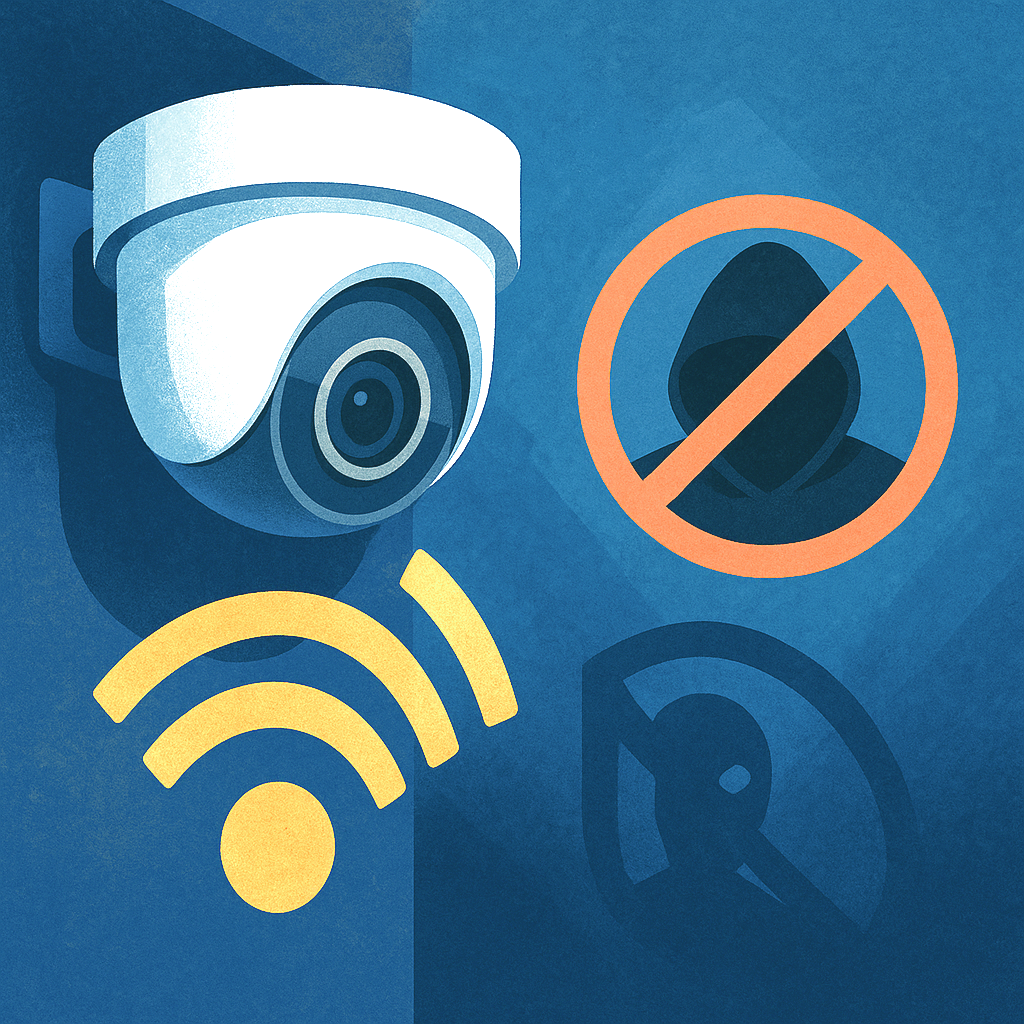Wi-Fi cameras are undeniably convenient: they’re easy to install, require no cable routing, and allow you to deploy a surveillance system in minutes. But this convenience often comes at a steep price — security. In environments where surveillance is meant to protect a home, office, or business, wireless cameras can easily become a Trojan horse rather than a safeguard.
Let’s examine the threats posed by Wi-Fi cameras, the types of real-world attacks that target them, and why, for mission-critical setups, wired solutions remain the gold standard.
The Deauthentication Vulnerability
Wi-Fi has a fundamental design flaw: management frames are not encrypted. This means that anyone within range of the network can spoof a “disconnect” command from the router and knock devices offline.
The attack can be executed with a cheap microcontroller like an ESP8266 running simple Wi-Fi Deauther firmware. The attacker scans for the network’s SSID, blasts the airwaves with deauthentication packets, and the cameras simultaneously lose connection. For minutes — or even hours — your surveillance system goes blind.
The consequences are obvious: recordings stop, alerts never arrive, and an intruder gains a risk-free window of opportunity.
Other Weaknesses of Wi-Fi Cameras
Deauthentication attacks are just the tip of the iceberg. Wireless cameras suffer from a range of other security problems:
- Weak passwords. Many users never change factory defaults or use trivially simple credentials.
- No authentication at all. Many budget IP cameras don’t require a password for local access — being on the same Wi-Fi network is enough. Anyone connected to the network (a guest, a neighbor, or an attacker) can open the web interface or pull the live stream.
- Traffic interception. If the camera doesn’t encrypt its video feed properly, that stream can be captured and decoded.
- Firmware vulnerabilities. Manufacturers often release updates slowly, and users rarely apply them.
- Unreliable cloud access. Cameras frequently connect to remote servers — sometimes in other countries — introducing privacy and data-leak risks.
- Lack of network segmentation. A compromised camera can become a stepping stone into the rest of your network.
Real-World Incidents
History is full of examples where camera vulnerabilities were actively exploited.
Some manufacturers have shipped devices with critical flaws that allow remote code execution without a password. Attackers could disable cameras, change settings, spy on the property, or even recruit the cameras into botnets.
Cheap models often have virtually no security: a serial number or MAC address can act as the key to the live stream. In those cases, anyone with the identifier could watch the feed and figure out when the premises were empty.
In several cases, devices had to be recalled or patched, but only those users who applied the firmware updates were protected — leaving many others vulnerable for years.
The Risks for Users
The whole point of surveillance is uninterrupted monitoring and reliable event logging. If a system can be taken down with a $5 gadget, its value plummets.
Wi-Fi cameras create multiple risks:
- Recordings stop at the worst possible moment.
- Crucial evidence is lost.
- Users develop a false sense of security — thinking they are protected while the system can be shut down in seconds.
- Attackers gain a bridge into the rest of the network.
- Private video archives and personal data can be leaked.
Why Radio Is Inherently Risky
Unlike wired solutions, Wi-Fi uses open radio frequencies that can be intercepted and analyzed from outside the building.
Even a password-protected network still broadcasts metadata, and management frames can be spoofed. The signal can be jammed with a cheap transmitter, and fake access points can trick cameras into reconnecting to a rogue network.
How to Reduce the Risks
If Wi-Fi cameras are unavoidable, harden them as much as possible:
- Enable WPA3 and management frame protection.
- Put cameras on a dedicated VLAN or guest network.
- Use strong, unique passwords and disable WPS.
- Keep firmware up to date.
- Avoid exposing cameras directly to the internet — use a VPN for remote access.
- Enable two-factor authentication wherever possible.
- Monitor device logs and network activity for anomalies.
Why Wired Solutions Are Safer
For high-security sites, wired PoE cameras remain the optimal choice. They deliver power and data over a single Ethernet cable, are immune to radio interference, and cannot be deauthenticated over the air.
Wired setups provide stable connections, consistent video quality, and centralized control through an NVR. Local storage keeps recordings physically on-site, reducing the risk of cloud-related leaks or outages.
Wi-Fi cameras are not inherently bad — they’re fine for temporary setups or low-risk applications. But when 24/7 protection is critical, wireless solutions are simply too easy to disable.
A motivated attacker with a pocket-sized device can take your system offline in minutes. In some cases, they don’t even need to hack anything — just connect to the same Wi-Fi network and open the video stream.
Wired systems with local storage and proper network design deliver the reliability that wireless simply cannot match.
When security matters, convenience must never outweigh resilience.
Examples of Vulnerable Cameras
- Eken V5 / Eken Doorbell – Wi-Fi video doorbells that expose their RTSP stream unless default settings are changed.
- Aiwit Video Doorbell / Mini Camera – vulnerable to serial-number-based access and local network snooping.
- Tenda CP3 – a budget panoramic camera with flaws allowing bypass of authentication.
- Wansview Q5 / K3 – early firmware versions exposed the video feed without a password.
- Yoosee and OEM clones – inexpensive Chinese models often requiring no password for local access, using weak cloud encryption.
- Tenvis legacy cameras – old models allowing bypass of authentication.
- Generic no-name IP cameras – often sold on marketplaces with open web interfaces and blank passwords, viewable by anyone who finds their IP address.

